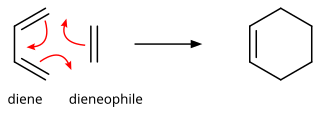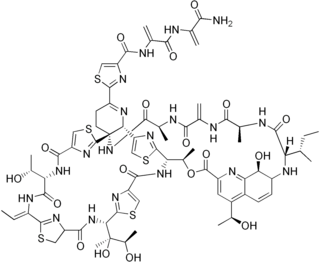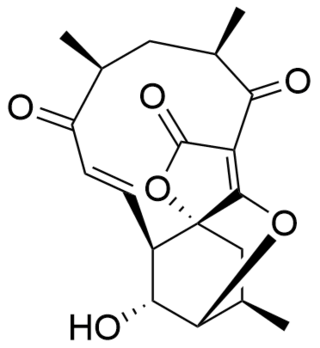
Kinamycins are a group of bacterial polyketide secondary metabolites containing a diazo group. Kinamycins are known for their cytotoxicity and are considered of interest for potential use in anti-cancer therapies. [1] [2]

Kinamycins are a group of bacterial polyketide secondary metabolites containing a diazo group. Kinamycins are known for their cytotoxicity and are considered of interest for potential use in anti-cancer therapies. [1] [2]
In 2006 and 2007 the means to totally and enantioselectively synthesize kinamycins C, F, and J were discovered. [3] [4] In 2010 a method was found to allow easier synthesis of these compounds in fewer steps, making research into their properties more feasible. [5]

Elias James Corey is an American organic chemist. In 1990, he won the Nobel Prize in Chemistry "for his development of the theory and methodology of organic synthesis", specifically retrosynthetic analysis. Regarded by many as one of the greatest living chemists, he has developed numerous synthetic reagents, methodologies and total syntheses and has advanced the science of organic synthesis considerably.

In organic chemistry, the Diels–Alder reaction is a chemical reaction between a conjugated diene and a substituted alkene, commonly termed the dienophile, to form a substituted cyclohexene derivative. It is the prototypical example of a pericyclic reaction with a concerted mechanism. More specifically, it is classified as a thermally-allowed [4+2] cycloaddition with Woodward–Hoffmann symbol [π4s + π2s]. It was first described by Otto Diels and Kurt Alder in 1928. For the discovery of this reaction, they were awarded the Nobel Prize in Chemistry in 1950. Through the simultaneous construction of two new carbon–carbon bonds, the Diels–Alder reaction provides a reliable way to form six-membered rings with good control over the regio- and stereochemical outcomes. Consequently, it has served as a powerful and widely applied tool for the introduction of chemical complexity in the synthesis of natural products and new materials. The underlying concept has also been applied to π-systems involving heteroatoms, such as carbonyls and imines, which furnish the corresponding heterocycles; this variant is known as the hetero-Diels–Alder reaction. The reaction has also been generalized to other ring sizes, although none of these generalizations have matched the formation of six-membered rings in terms of scope or versatility. Because of the negative values of ΔH° and ΔS° for a typical Diels–Alder reaction, the microscopic reverse of a Diels–Alder reaction becomes favorable at high temperatures, although this is of synthetic importance for only a limited range of Diels-Alder adducts, generally with some special structural features; this reverse reaction is known as the retro-Diels–Alder reaction.

The Corey–Itsuno reduction, also known as the Corey–Bakshi–Shibata (CBS) reduction, is a chemical reaction in which an achiral ketone is enantioselectively reduced to produce the corresponding chiral, non-racemic alcohol. The oxazaborolidine reagent which mediates the enantioselective reduction of ketones was previously developed by the laboratory of Itsuno and thus this transformation may more properly be called the Itsuno-Corey oxazaborolidine reduction.

Paclitaxel total synthesis in organic chemistry is a major ongoing research effort in the total synthesis of paclitaxel (Taxol). This diterpenoid is an important drug in the treatment of cancer but, also expensive because the compound is harvested from a scarce resource, namely the Pacific yew. Not only is the synthetic reproduction of the compound itself of great commercial and scientific importance, but it also opens the way to paclitaxel derivatives not found in nature but with greater potential.

Schwartz's reagent is the common name for the organozirconium compound with the formula (C5H5)2ZrHCl, sometimes called zirconocene hydrochloride or zirconocene chloride hydride, and is named after Jeffrey Schwartz, a chemistry professor at Princeton University.This metallocene is used in organic synthesis for various transformations of alkenes and alkynes.
Robert S. Coleman is an American chemistry professor and researcher. Coleman was a faculty member at both Ohio State University and the University of South Carolina. At Ohio State, he was on the faculty in the Department of Chemistry from 1996 to 2012, having moved to Ohio State as an associate professor from the University of South Carolina. At USC, Coleman taught as assistant professor from 1989 to 1995, and then as associate professor from 1995 to 1996. In 1996, he accepted a faculty position at Ohio State University to teach Organic Chemistry, where he was an associate professor from 1996 until 2000. He was promoted to full professor in 2000, teaching Organic Chemistry up until his retirement in 2012. He received his Ph.D. degree working with Professor Dale L. Boger, completing the first total synthesis of the antitumor agent CC-1065. He was subsequently an NIH postdoctoral fellow at Yale University with Professor Samuel J. Danishefsky, where he completed, the first total synthesis of the aglycone of the antitumor agent calicheamicin.

Thiostrepton is a natural cyclic oligopeptide antibiotic of the thiopeptide class, derived from several strains of streptomycetes, such as Streptomyces azureus and Streptomyces laurentii. Thiostrepton is a natural product of the ribosomally synthesized and post-translationally modified peptide (RiPP) class.

In organic chemistry, enediynes are organic compounds containing two triple bonds and one double bond.
The Tsuji–Trost reaction is a palladium-catalysed substitution reaction involving a substrate that contains a leaving group in an allylic position. The palladium catalyst first coordinates with the allyl group and then undergoes oxidative addition, forming the π-allyl complex. This allyl complex can then be attacked by a nucleophile, resulting in the substituted product.

The cortistatins are a group of steroidal alkaloids first isolated in 2006 from the marine sponge Corticium simplex. The cortistatins were first discovered in a search for naturally occurring compounds that inhibit proliferation of human umbilical vein endothelial cells (HUVECs), with cortistatin A being the most potent compound in the class.
Cylindrocyclophanes are a class of cyclophane, a group of aromatic hydrocarbons composed of two benzene rings attached in a unique structure. Cylindrocyclophanes were the first cyclophanes found in nature, isolated from a species of cyanobacteria, and have proven to be an interesting group of compounds to study due to their unusual molecular structure and intriguing biological possibilities, especially its cytotoxicity to some cancer cell lines.

Secalonic acids are a group of chiral dimeric tetrahydroxanthones closely related to ergoflavin and ergochrysin A that are collectively called ergochromes and belong to a class of mycotoxins initially isolated as major ergot pigments from the fungi Claviceps purpurea that grows parasitically on rye grasses. From early times and particularly in medieval Europe the consumption of grains containing ergot has repeatedly lead to mass poisonings known as ergotism which was caused by toxic ergot alkaloids and mycotoxins such as the ergochromes, due to contamination of flour by C. purpurea. A cluster of genes responsible for the synthesis of secalonic acids in C. purpurea has been identified. Secalonic acid D the enantiomer of secalonic acid A is a major environmental toxin, isolated from the fungus Penicillium oxalicum, and is a major microbial contaminant of freshly-harvested corn which causes toxicity through contamination of foodstuffs.

Lavendamycin is a naturally occurring chemical compound discovered in fermentation broth of the soil bacterium Streptomyces lavendulae. Lavendamycin has antibiotic properties and anti-proliferative effects against several cancer cell lines. The use of lavendamycin as a cytotoxic agent in cancer therapy failed due to poor water solubility and non-specific cytotoxicity. The study of lavendamycin-based analogs designed to overcome these liabilities has been an area of research.

Stephacidin A and B are antitumor alkaloids isolated from the fungus Aspergillus ochraceus that belong to a class of naturally occurring 2,5-diketopiperazines. This unusual family of fungal metabolites are complex bridged 2,5-diketopiperazine alkaloids that possess a unique bicyclo[2.2.2]diazaoctane core ring system and are constituted mainly from tryptophan, proline, and substituted proline derivatives where the olefinic unit of the isoprene moiety has been formally oxidatively cyclized across the α-carbon atoms of a 2,5-diketopiperazine ring. The molecular architecture of stephacidin B, formally a dimer of avrainvillamide, reveals a complex dimeric prenylated N-hydroxyindole alkaloid that contains 15 rings and 9 stereogenic centers and is one of the most complex indole alkaloids isolated from fungi. Stephacidin B rapidly converts into the electrophilic monomer avrainvillamide in cell culture, and there is evidence that the monomer avrainvillamide interacts with intracellular thiol-containing proteins, most likely by covalent modification.
Proline organocatalysis is the use of proline as an organocatalyst in organic chemistry. This theme is often considered the starting point for the area of organocatalysis, even though early discoveries went unappreciated. Modifications, such as MacMillan’s catalyst and Jorgensen's catalysts, proceed with excellent stereocontrol.

Atrop-abyssomicin C is a polycyclic polyketide-type natural product that is the atropisomer of abyssomicin C. It is a spirotetronate that belongs to the class of tetronate antibiotics, which includes compounds such as tetronomycin, agglomerin, and chlorothricin. In 2006, the Nicolaou group discovered atrop-abyssomicin C while working on the total synthesis of abyssomicin C. Then in 2007, Süssmuth and co-workers isolated atrop-abyssomicin C from Verrucosispora maris AB-18-032, a marine actinomycete found in sediment of the Japanese sea. They found that atrop-abyssomicin C was the major metabolite produced by this strain, while abyssomicin C was a minor product. The molecule displays antibacterial activity by inhibiting the enzyme PabB, thereby depleting the biosynthesis of p-aminobenzoate.

Carbocyclic nucleosides are nucleoside analogues in which a methylene group has replaced the oxygen atom of the furanose ring. These analogues have the nucleobase attached at a simple alkyl carbon rather than being part of a hemiaminal ether linkage. As a result, they have increased chemical stability. They also have increased metabolic stability because they are unaffected by phosphorylases and hydrolases that cleave the glycosidic bond between the nucleobase and furanose ring of nucleosides. They retain many of the biological properties of the original nucleosides with respect to recognition by various enzymes and receptors.

Shishijimicin A is an enediyne antibiotic isolated from Didemnum proliferum. Isolated in 2003 it is part of the family of 10 member ringed enediyne antitumor antibiotic agents, which includes: namenamicin, esperamicin and, calicheamicin. Due to its high potency from cytotoxicity, Shishjimicin A is currently undergoing testing as a possible Antibody-antibiotic Conjugate (ADCs) cancer treatment. Laboratory tests indicate it to be “more than 1,000 times as toxic to cancer cells as the anticancer drug taxol”, also known as Paclitaxel, a prevalent chemotherapy medication. As such, theoretically, only an administration of a minuscule dose of the molecule would be necessary per each treatment. As shishjimicin A supply is scarce and the full extent of its side effects is not yet established, there is still a need for further biological and clinical studies.
Corinna S. Schindler is a Professor of Chemistry at the University of Michigan. She develops catalytic reactions with environmentally benign metals such as iron, towards the synthesis of biologically active small molecules. For her research in the development of new catalysts, Schindler has been honored with several early-career researcher awards including the David and Lucile Packard Foundation Fellowship in 2016, the Alfred P. Sloan Fellowship in 2017, and being named a member of the C&EN Talented 12 in 2017. Schindler has served on the Editorial Board of Organic and Bimolecular Chemistry since 2018.
F. Dean Toste is the Gerald E. K. Branch Distinguished Professor of Chemistry at the University of California, Berkeley and Faculty Scientist at the Chemical Sciences Division of Lawrence Berkeley National Lab. He is a prominent figure in the field of organic chemistry and is best known for his contributions to gold chemistry and asymmetric ion-pairing catalysis. Toste was elected a member of the National Academy of Sciences in 2020, and a member of the American Academy of Arts and Sciences in 2018.